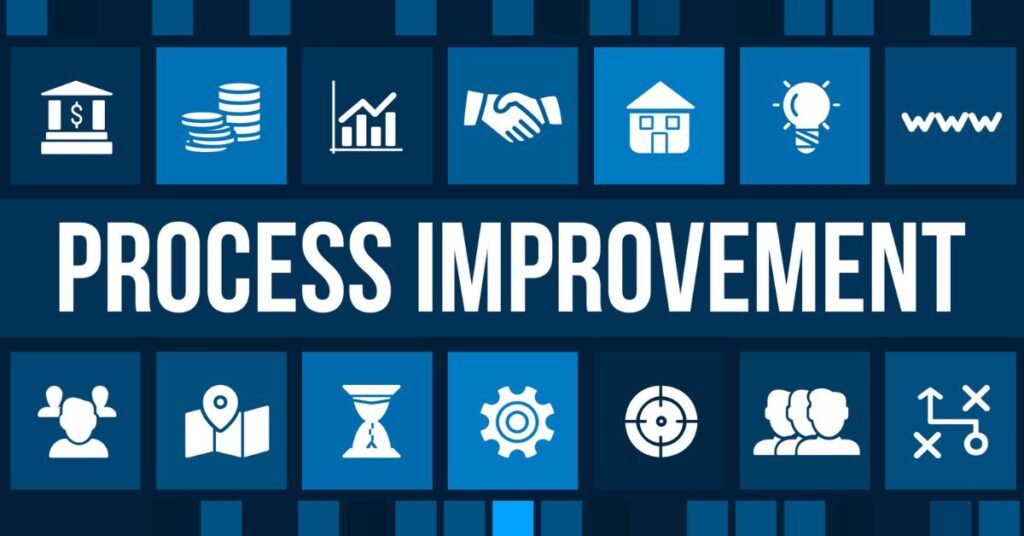What are Process Improvement Models? Everything You Need to Know for Enhanced Efficiency

In the business world, where competition is fierce, organizations need to make their operations more efficient and productive. In this scenario, process improvement becomes vital for companies looking to refine their operations by cutting wastefulness and maximizing resource use. Models for process improvement guide businesses through significant changes with detailed strategies and necessary tools to simplify complex steps.
With structured methods, companies can develop strategies to identify and tackle problems in intricate processes. Using these unique approaches, organizations target operational bottlenecks, making changes that yield tangible improvements. Process improvement models serve as powerful drivers, propelling businesses toward operational excellence by speeding up market delivery, enhancing product quality, and boosting customer satisfaction.
In this blog, we dive into seven transformative process improvement models, showcasing their impact on achieving higher efficiency and effectiveness.
7 Process Improvement Models for Efficiency
1. Lean Methodology
 Lean methodology actively streamlines business processes, closely scrutinizing each step to eliminate any redundant elements. This approach, rooted in principles of continuous improvement, employs “value stream mapping”. Practitioners of Lean divide tasks into three key categories: value-adding, necessary but not value-adding, and unnecessary.
Lean methodology actively streamlines business processes, closely scrutinizing each step to eliminate any redundant elements. This approach, rooted in principles of continuous improvement, employs “value stream mapping”. Practitioners of Lean divide tasks into three key categories: value-adding, necessary but not value-adding, and unnecessary.
By categorizing each action, the Lean methodology promotes process improvement and eliminates inefficiency. Targeting the crucial goal of waste reduction, this strategy enhances workflows, making them smoother, faster, and more cost-effective. Therefore, embracing Lean principles signals a commitment to not just cost-cutting but improving efficiency. With these methods, businesses observe tangible benefits such as an acceleration in workflows without sacrificing quality or inflating expenses.
2. Six Sigma
Six Sigma stands out as a rigorously disciplined and data-centric approach, focusing sharply on eradicating defects and reducing variability. It first made waves in the 1980s thanks to Motorola’s pioneering efforts, resting on a simple yet effective principle: meticulously track “defects” in any process, and begin eliminating them methodically aimimng for a “zero defects” scenario. The essence of Six Sigma unfolds through five pivotal steps: First, define the areas needing focus; then, measure the current performance; next, analyze reasons for deviations; following that, improve with precise solutions; and lastly, control to maintain the gains. These steps create the DMAIC method, which is known for driving success in numerous fields.
Organizations embark on a transformative journey toward enhanced efficiency and quality by rigorously adhering to these phases. They excel at making processes better through smart strategies, such as actively counting errors and eliminating them head-on, capturing the very essence of improvement succinctly.
This method utilizes statistical instruments to determine the fundamental causes of deficiencies and highlight areas that can be enhanced. It steadfastly ensures that all resolutions are founded on empirical data. Thus, Six Sigma embraces a practice where active decision-making is informed by quantifiable evidence rather than unverified assumptions.
ALSO READ: What is Capacity Planning? A Simple Guide
3. Agile Methodology
Agile philosophy has emerged as a beacon of adaptability and responsiveness. With roots in software development, Agile has now transcended its original domain to become an indispensable approach for process improvement across diverse sectors. At its core lies iterative development; this principle advocates that solutions should evolve through collaborative efforts between self-organizing cross-functional teams.
Adopting this mindset ensures readiness to adjust processes swiftly while ensuring teamwork and leveraging diverse expertise without succumbing to bureaucracy. Industries adopting these methods see improved efficiency and outcomes. Focusing on continuous evolution over fixed plans keeps organizations agile and responsive, a key asset in today’s volatile market where quick pivots are crucial. This shift to regular fine-tuning, propelled by unified teams with varied skills, embodies Agile’s success. It is the perfect blend of speed and smart adaptation, necessary for thriving on diversity in a fast-evolving business world.
4. Kaizen
In process enhancement, Kaizen stands out, transforming how organizations view efficiency and quality. A Japanese word, “kaizen” loosely translates to mean “change for the better” or “continuous improvement”. This philosophy motivates employees at all levels to work together to steadily improve their work processes. Kaizen fosters a mindset encouraging everyone to make small, ongoing improvements in workplace methods through continuous refinement and teamwork.
Elements such as teamwork, commitment, improved morale, quality groups, and idea sharing are at the core of the Kaizen methodology. By concentrating on these aspects, Kaizen adeptly integrates a company’s collective expertise. Inevitably, this integration helps to propels organizational growth and catalyzes continuous positive transformation.
ALSO READ: How to Become an Ops Manager? Top 6 Production Skills
5. Business Process Re-Engineering
 Business Process Re-engineering (BPR) marks a radical shift in process improvement, pushing for total overhauls over minor tweaks. It aims for sharp enhancements in cost, quality, service, and speed, diverging from gradual improvements by seeking deep transformations. As mentioned above, this approach does not settle for slight refinements; it is about a complete operational reboot. By entirely rethinking workflows, BPR sets businesses up for not just minor but major strides in all operational facets. Essentially, BPR defies traditional methods by advocating for revolutionary, not incremental, changes—all to significantly boost efficiency.
Business Process Re-engineering (BPR) marks a radical shift in process improvement, pushing for total overhauls over minor tweaks. It aims for sharp enhancements in cost, quality, service, and speed, diverging from gradual improvements by seeking deep transformations. As mentioned above, this approach does not settle for slight refinements; it is about a complete operational reboot. By entirely rethinking workflows, BPR sets businesses up for not just minor but major strides in all operational facets. Essentially, BPR defies traditional methods by advocating for revolutionary, not incremental, changes—all to significantly boost efficiency.
6. Continuous Improvement
Continuous improvement is a fundamental philosophy pivotal to the success of numerous process-improvement strategies in a dynamic business landscape. This concept is embraced by leading companies in their endeavor to regularly refine their processes, products, or services through incremental adjustments that cumulatively enhance quality and efficiency. Furthermore, unlike certain models seeking substantial overhauls, continuous improvement advocates steady evolution and adaptation. Essentially, this approach focuses not on dramatic transformations but rather on small yet impactful enhancements. At its core, this mindset champions ongoing betterment—a commitment to progressive change without aiming for overnight revolution.
Additionally, continuous improvement ensures organizations make consistent strides toward optimization instead of sporadic leaps. In fact, it is about fine-tuning every aspect to gradually elevate performance standards. By valuing each minor advancement toward excellence systematically taken over time—whether in production or operations—businesses can steadily journey along the path toward perfection with unwavering directionality.
7. Workflow Optimization
Finally, workflow optimization focuses on improving the efficiency of business workflows to maximize productivity and reduce waste. By analyzing and redesigning workflows, companies can create more streamlined, efficient processes that contribute to overall business success. Furthermore, this involves not only the elimination of unnecessary steps and the reduction of bottlenecks but also the integration of technology to automate repetitive tasks.
Workflow optimization complements process improvement seamlessly, ensuring not only the effectiveness of processes but also their execution in the most efficient way possible. Moreover, this synergy between the two drives organizational success, streamlining operations and enhancing productivity. Additionally, through the thoughtful design and continuous evaluation of workflows, organizations can achieve a balance between efficiency and effectiveness, driving superior performance and value creation.
ALSO READ: A Comprehensive Guide to Operations Management: 10 Key Principles
Frequently Asked Questions About Process Improvement Models
1. How Can Process Improvement Models Benefit My Organization?
Process improvement models can help organizations identify inefficiencies, reduce costs, improve quality, and enhance customer satisfaction. Hence, by adopting these models, businesses can achieve a competitive advantage and foster a culture of continuous improvement.
2. What are the Key Principles of Lean Methodology?
The key principles of Lean methodology include identifying value, mapping the value stream, creating flow, establishing pull, and seeking perfection. Therefore, by focusing on these principles, organizations can eliminate waste and streamline their operations.
3. How Can the Agile Methodology Help in Increasing Efficiency?
The Agile methodology helps increase efficiency by promoting flexibility, collaboration, and customer-centric development. Consequently, teams can respond more quickly to changes and deliver higher-quality outcomes.
4. What is the Difference Between Six Sigma and Kaizen?
While Six Sigma focuses on reducing process variability and defects, Kaizen emphasizes continuous, incremental improvements. Therefore, both approaches offer valuable strategies for process improvement but from different perspectives.
5. How Can Business Process Re-Engineering Transform Operations for the Better?
Business process re-engineering can transform operations by rethinking and radically redesigning business processes to achieve dramatic improvements in critical areas such as cost, quality, service, and speed.
ALSO READ: Who is an Operations Manager, Salary, Skills & Career
In summary, the adoption of process improvement models is necessary for organizations that want to improve their operational effectiveness and maintain a competitive edge. Additionally, whether it is Lean methodology, Six Sigma or Agile, or any of the methodologies discussed above, each model provides a way to achieve big performance improvements. Hence, those who are interested in going further into operational excellence should consider looking at Emeritus’ operations management courses to gain useful knowledge and skills.
Write to us at content@emeritus.org






